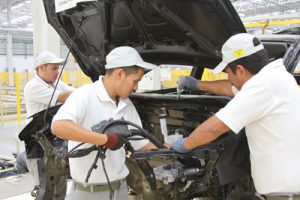All systems ‘go’ at Nissan
*This article is part of a special focus on Mexico. For other features related to the automotive supply chain in Mexico click here; for more on finished vehicle logistics in Mexico click here.
In fifth part of our Automotive Logistics Mexico special, Nissan Mexicana's logistics specialists explain how the carmaker, together with its Alliance partners, are planning on reducing costs and increasing synergies at a time of extensive growth within Mexico and for global flows and exports
 Nissan Mexicana (NMEX), the country’s largest carmaker by production volume and domestic sales, has plans to become even bigger. The OEM’s new plant in Aguascalientes – its second in the city and third in Mexico – has already increased production capacity to 850,000 units this year. Chief executive Carlos Ghosn has confirmed the plan to build 1m vehicles in Mexico by 2016, of which around 700,000 will be exported. To put that in perspective, in 2013 Nissan exported more than 542,000 vehicles from Japan.
Nissan Mexicana (NMEX), the country’s largest carmaker by production volume and domestic sales, has plans to become even bigger. The OEM’s new plant in Aguascalientes – its second in the city and third in Mexico – has already increased production capacity to 850,000 units this year. Chief executive Carlos Ghosn has confirmed the plan to build 1m vehicles in Mexico by 2016, of which around 700,000 will be exported. To put that in perspective, in 2013 Nissan exported more than 542,000 vehicles from Japan.
To add even more to Nissan's footprint in Mexico, Renault Nissan and Daimler announced at the end of June that together they will build yet another plant in Aguascalientes for joint venture production of first Infiniti models by 2017, and Mercedes-Benz passenger cars by 2018. The plant will have a 300,000-unit annual capacity when it is fully ramped up by 2021. While full details of how the joint venture will manage its supply chain have yet to be discussed, Renault Nissan chief executive Carlos Ghosn has said that the two OEMs would cooperate on all aspects of engineering, design and production. Daimler's chairman of the board of management, Dieter Zetsche, pointed out that Nissan's existing infrastructure and supply base in Aguascalientes and Mexico would be a "big advantage" for logistics.
For Nissan and other OEMs, the issues for logistics in Mexico are already very clear: there are questions over infrastructure, transport assets, security, labour skills and facilities. As the biggest producer, Nissan is certainly not immune to any of them. However, it is also the carmaker that has arguably invested the most in its internal resources to manage the supply chain in Mexico. Nissan is somewhat unique in the country for its level of in-house logistics management for inbound; only a few trade lanes are outsourced to third party providers, while a central team in Aguascalientes engineers and designs most of its network (although staff are also based at the plants to run day-to-day operations and certain production control tasks). This includes a packaging design and engineering team. Furthermore, the carmaker uses an in-house transport management system for its freight flows. The way that Nissan (and indeed its Alliance partner Renault) is organised globally, there is also a supply chain management team that is responsible for parts and vehicle programming, production control, in-plant and yard-related logistics.

The in-house exception for Nissan Mexicana is for outbound logistics, where WWL is the principal third party provider for yard and transport operations, including a considerable amount of labour services.
The man with local responsibility for Nissan’s logistics in Mexico is Daniel Saenzpardo, head of inbound and outbound logistics management, packaging, aftermarket transport and logistics cost management across the OEM’s factories in Aguascalientes and Cuernavaca, south of Mexico City, as well as the import and export of parts and vehicles, and management of Nissan’s distribution network.
There are a number of important cost targets and improvements for Nissan’s logistics (see box). According to Saenzpardo, many network and process changes have come from Nissan’s ‘total delivered cost’ (TdC, in Nissan parlance) strategy across North America, which has sought to reduce the cost of the supply chain up to vehicle delivery.
“The main impact of the TdC strategy was to be more competitive not just in terms of cost, but also in terms of performance and management,” says Saenzpardo. “TdC has changed the way we work in Mexico operationally and in commercial terms. We worked together with our transportation suppliers’ panel to be more efficient and we also tried to establish synergies to improve the flows to the plants.”
Saenzpardo points to supplier localisation as another important development for NMEX; in fact, the carmaker may be in the midst of an important transition. Although growing volume has increased global material imports to Mexico, including from the US, Japan, and Europe, the carmaker continues to expand its local supply base. For example Jatco, a Nissan subsidiary that builds transmissions and other components, will open its second plant in Aguascalientes later this year. With the increase of shared platforms across both Renault and Nissan, Saenzpardo also expects Mexico to become even more of a hub for parts exports, serving other regions that produce the same platforms. That trend may well accelerate with the later production of Infiniti and Mercedes-Benz models. In that way, the impact for Nissan of Mexico’s growth is far from just a regional one for logistics – it has global repercussions.
Christopher Ludwig spoke to Daniel Saenzpardo about Nissan’s operations in Mexico in June prior to the announcement about the new joint venture plant in Aguascalientes:
Ludwig: How competitive are logistics and supply chain costs for Nissan in Mexico in relation to other major markets?
Saenzpardo: The cost of logistics is quite competitive within the North American region. Nissan manages some logistics cost from Japan through a global maritime bid, while NMEX manages other costs locally.
How much material is sourced locally for Mexican plants compared the parts you import from the US, Canada and further afield?
Approximately 84% of total cargo volume comes from Mexico and the remainder from overseas, including the US and Canada.
How has imported material been evolving in recent years?
We are observing an increase but that is driven mainly by our production volume increase.
Whether as part of your ‘total delivered cost’ strategy or otherwise, has Nissan increased Mexico sourcing?
In particular for NMEX, yes, we are increasing the local sourcing for the models produced in Mexico. It is an advantage from a quality, cost and delivery standpoint.
How does the export of material from Mexico compare to imported components?
The export business is growing, but it is still far from the import operation. On average, for every 4 FEU (forty-equivalent unit containers) that we import, we are exporting 1.5 FEU.
How do you expect global material flows will change, particularly with more global and shared platforms being built across the Renault-Nissan Alliance in Europe, Asia and the Americas?
Although the Renault-Nissan Alliance is increasing its global and shared platforms, Mexico is looking for further localisation of components in the North American region; therefore, the expectation is to observe a reduction in the import flows and increase exports to other countries to support global multi-site production.
Does Nissan have strong visibility over its international inbound chain? Does it integrate this with vehicle orders, build plans and material orders?
Yes, the international supply chain is integrated in our MRP system linked to our vehicle manufacturing planning system.
Nissan has highly integrated logistics operations across North America. Have you started to work together more closely across Latin America, especially Brazil?
For the Latin American market, Nissan Mexicana supports operations across the region in two principle ways: one is vehicle transportation to the national sales companies by sea, and the other way is aftersales shipments by sea. In Brazil, particularly for the new Nissan plant in Resende, the company has its own local logistics organisation and NMEX is just supporting the team if needed for any topic. For the Brazilian market, however, we are shipping vehicles and supporting wholesale and retail sales as much as possible.
What would you like to improve most for intercontinental supply chain flows to Nissan plants in Mexico?
Vessel services are the main factor where we would like to see improvement, since the service offer is limited. We see that the reliability in the service is jeopardised without seeing the competence to improve.
The ambition to build 1m vehicles per year in Mexico isn’t the only aggressive target for Nissan’s supply chain management. As part of its global ‘Power 88’ strategy, Nissan has a goal of reducing costs by 5% every year for the next three consecutive years.
“That is a very aggressive target and we are working with our supply chain to ensure that we reach it,” says Sofia Garcia, responsible for logistics purchasing for Nissan in Mexico.

While plans to expand by around 300,000 units over those three years will certainly give Nissan more economies of scale, the carmaker’s logistics and purchasing executives maintain that the cost savings will not come by pressing down rates on logistics providers. “We cannot get that 5% by direct negotiations alone,” says Garcia. “We have many suppliers who have been working with us for a long time and they are now experts that can help find us better strategies and better ways of doing logistics.”
Not that the higher volume will hurt in negotiations. Garcia says that Nissan bundles its logistics volume together wherever possible and selects providers who are best able to manage it. However, Nissan’s management sees the scale more as a means of improving equipment utilisation than as a pure purchasing power tool. Chris Styles, who is responsible for Nissan’s logistics across North America, says a lot of the cost saving will come from re-engineering inbound and outbound logistics flows.
“Economies of scale help, but they do not resolve everything,” he says. “It’s important especially to become more flexible, as lacking flexibility is what can really drive up costs.”
Styles confirms that the cost reduction won’t be in absolute terms, but rather based on the total cost of delivery per vehicle. “It is not going to be 5% in one area, or in rate reductions either,” he says. “It will come from being more efficient in transport or in labour-providing services.”
In some ways, the reduction is even more ambitious than it may sound, given fuel costs in Mexico are set to increase over the entire target period. Garcia observes that the Mexican government is withdrawing subsidies and that costs are expected to rise every month for at least the next three years. The costs of toll roads are also on the up. All the more reason why running a smarter, more efficient network will be the main way to achieve the targets.
Border nights
How would you describe the current material flows between Mexico and the US for Nissan?
Northbound-southbound flows are not balanced as a region for Nissan. Between the US and Mexico plants’ requirements, we are exporting more parts northbound to the US than we are importing southbound.
Has a change in the balance impacted your cross-border logistics services?
Yes, the change impacts our operations, as there is a lack of service to cover Mexico pickups right now.
For US-Mexico flows, does Nissan use ‘door-to-door’ services or do you manage transport and customs by lane through your own management?
We handle the flows ourselves, but we can do border transfers.
How much cross-border flow moves by rail and and truck?
The use of rail in our operations is limited so most of the cargo is moved over the road.
Are there any areas at the border where Nissan is experiencing congestion and delays?
There is congestion at Laredo when crossing the border. The services by rail are definitely smoother in this regard.
How efficient are Nissan’s load factors for material moving over the border? Are they better by rail or truck?
For Nissan, truck and rail services have a similar efficiency since we use 53ft (16-metre) containers for our operations.
What could most improve about cross-border logistics?
We would like to see improved security at the border. We would also like to balance the use of the crossing points to avoid overflow.

In-plant kitting and long-distance packaging
Has Nissan outsourced its in-plant logistics and warehousing activities in Mexico, or kept these in-house?
Nissan keeps these logistics operations in-house.
At some Nissan plants in the US, there are tier suppliers operating within the plant and delivering directly to the line. Is this the case also in Mexico?
Yes, we have three suppliers within the plant delivering direct to the line.
At a number of global factories, I have noted an increase in kitting in respect to kanban or sequencing. Has this been the case for Nissan in Mexico as well?
Yes it is. For example, in the case of trim and chassis we have approximately 95% of kit supply. We have also increased the number of AGVs that we are using at the plants.
I understand there is a supplier park at Aguascalientes. What kind of suppliers are localised there? Do you expect to carry out logistics services at the supplier park?
So far the supplier park was designed for synchronised suppliers. We are looking also for some satellite logistics operations handled by Nissan, but as of today we have no vision of logistics services providers being located at the supplier park.
Do you manage a loop for returnable packaging in Mexico?
Yes, this covers approximately 90% of our packaging.
Are you using any long-distance returnable packaging, whether for NAFTA or other locations?
Yes we are, including for material moving between Mexico and Japan, the US, Spain and others.
For domestic inbound logistics in Mexico, does Nissan also work directly with its carriers, or are there more 3PL services?
We manage these services directly with carriers.

Do you have any intermodal services for domestic freight in Mexico?
No, the transit time would be too long for rail or intermodal versus over-the-road services.
How efficient would you describe the inbound trucking network in terms of pickup and delivery accuracy?
We have good flexibility to align pickup and delivery according to the speed of our production plants.
How you had any issues with network delays leading to line stoppages or slowdowns?
This is not an issue for our current inbound operations.
In general, how would you describe the amount of premium or expedited freight into Mexico lately?
It has been stable over the last year.
Are carriers in Mexico providing sufficient capacity and frequency?
At the current size, based on the production plans, we are not yet facing any capacity constrains. However, unexpected volume increases can impact the capacity, so with our midterm plan we work with all the carriers to ensure we reach the right capacity year over year.

I have heard examples of some companies using trucks in Mexico longer than the 53ft standard in North America. Has Nissan gone in this direction as well?
Yes we have, and we are moving our operation in that direction as part of our efficiency improvement strategies.
Elsewhere in the world, Nissan has made efforts to simplify the supply chain, including for logistics. Has that been the case for NMEX as well?
For logistics we are attempting to simplify or reduce the complexity among the transportation suppliers to improve the service level for our customers – and in particular for manufacturing plants. We look for standard operations with fewer suppliers that allow us to have a better performance and control of operations and to improve them.
Have theft and vandalism been an issue for Nissan in Mexico, as other companies have reported? What is being done to improve this?
Right now theft is not an issue as such for Nissan. The vandalism levels are reducing and the conditions are improving. For vandalism, the main impact is felt for rail transport rather than truck, and is found mainly in Mexico’s central region. We are developing a new service to reduce the transit time, including reducing or avoiding stops along the route; this will help to minimise damages or vandalism.
What would you like to see improve most about domestic inbound logistics in Mexico?
As part of the Nissan mindset we are looking for a lean logistics operation in which the production synchronisation is linked with the inbound logistics.





